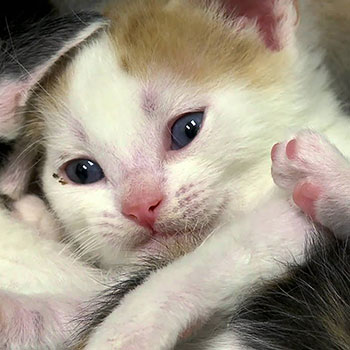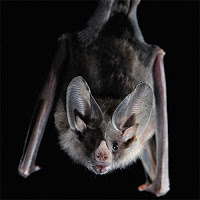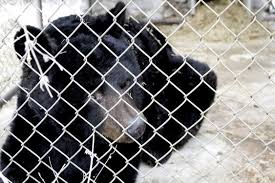"HERO PEOPLE OF THE WEEK" - Keri Lamar - Freeway Kitten
 Our Hero Person this week is the heartwarming story about a kitten that was abandoned on a highway and rescued by Keri Lamar. Keri was driving when all of a sudden a kitten flew by her windshield. Keri tells the rest of the story.
Our Hero Person this week is the heartwarming story about a kitten that was abandoned on a highway and rescued by Keri Lamar. Keri was driving when all of a sudden a kitten flew by her windshield. Keri tells the rest of the story.
Keri LaMar is a big animal lover and rescuer. One day she was on her way to pick up a dog and was driving on the 60 Freeway East of Los Angeles, when she saw something fly by the window of her car.
She was driving in the fast lane when all of a sudden what appeared to be a tiny kitten went flying past her windshield. Unfortunately things happened so quickly, she didn't get a look at the vehicle that tossed the kitten.
Keri knew she couldn't live with herself if she didn't do anything to help the kitten, so she immediately pulled over to the center divider and got out of her car to look for it.
She walked quite a distance and not finding anything, thought perhaps she was just seeing things. She then looked over the center divider and saw the kitten on the other side of the freeway. Keri was worried that the kitten would run into traffic. She climbed over the center divider while cars were honking at her, probably wondering what she was doing!
 When she got close to the kitten, Keri was afraid he would run. Luckily, she was able to reach down and grab him before he knew what was going on. The kitten was pretty traumatized and kept biting Keri. Keri talked to the kitten and told him, "It's okay little fellow, just keep biting, but I'm not going to let you go."
When she got close to the kitten, Keri was afraid he would run. Luckily, she was able to reach down and grab him before he knew what was going on. The kitten was pretty traumatized and kept biting Keri. Keri talked to the kitten and told him, "It's okay little fellow, just keep biting, but I'm not going to let you go."
Keri took the kitten to the vet, who said that he only had some minor abrasions but was still pretty traumatized. The kitten stayed at the vet's office for a few days and then was adopted by one of Keri's good friends.
He was named Marvin and Keri gets to see him often. She said it took him some time to adjust, but is now a very sweet, loving cat.
Looking back, Keri still gets the chills just thinking about what could have happened to the both of them.
Keri grew up in Southern California, and for as long as she can remember, she has felt a strong connection to the animals. Keri even started her own non-profit 501(c)(3) Animal Rescue in the State of California, "Kisses and Paws," with her husband Jim.
Visit Website
CLIX - Basic Training Tools
Dr. Roger Mugford, The Company of Animals
 Every dog owner should have several basic training tools. Founder of the Animal Behavior Centre and inventor of the Halti, Dr. Roger Mugford will be explaining what you need to train your dog to sit, stay and come.
Every dog owner should have several basic training tools. Founder of the Animal Behavior Centre and inventor of the Halti, Dr. Roger Mugford will be explaining what you need to train your dog to sit, stay and come.
Dr. Roger Mugford is a psychologist and farmer who introduced the concept of behavioral therapy to the veterinary profession by founding The Animal Behavior Centre in 1979. Since then, his referral practice is seen as the leading authority in the field and has seen more than 50,000 pets. He invented the Halti head collar plus other training and reward based behavior aids distributed by The Company of Animals, of which he is the CEO.
Today, Dr. Mugford discusses the CLIX range by the Company of Animals. With Clickers, Whistles, Target Sticks, long lines and more, you are sure to find the right product for your training needs.
He starts with the CLIX Multi-Clicker, which has two different sounding clicks. He states this isn't to train two different dogs, but that dogs have different hearing sensitivities. For example, breeds like Cocker Spaniels and Border Collies are very sound sensitive, where less is usually better. But with other breeds, like thick-skulled Labradors and Boxers, you really need to shout at them and be loud to get a response.
Dogs differ in their hearing sense by breed and by size, and smaller breed dogs have better hearing sensitivity. You don't want to frighten dogs, especially puppies, when they are first exposed to a clicker.
 Clickers are associated with a reward, a sort of payoff. Once they realize a clicker sound means they are doing the right thing, in the future it can be associated with the dog performing something that you want him to do. This can be lying down, staying and retrieving an object. You can even clicker train your dog to dance to music, which is the big fad at the moment on both sides of Atlantic.
Clickers are associated with a reward, a sort of payoff. Once they realize a clicker sound means they are doing the right thing, in the future it can be associated with the dog performing something that you want him to do. This can be lying down, staying and retrieving an object. You can even clicker train your dog to dance to music, which is the big fad at the moment on both sides of Atlantic.
Included with the Clicker is an in-depth pamphlet on how to train your dog with the clicker. You don't need a really smart dog, as clicker training is very easy and simple.
Another great product is the CLIX Whistle. Whistle training is a great way to teach your dog commands from a distance. The range includes a two-tone whistle, a referee whistle, silent whistle, multi-purpose whistle and a Professional Whistle.
They have also included a way train your dog to do more in a secure but free way using a recall line. With the CLIX 32ft Recall Line, you can train your dog under control but in a seemingly free way for them, making it ideal for controlled socialization of puppies or aggressive dogs.
And they didn't forget the treats. When it comes to training your dog you won't be complete without the CLIX Treat Bag. Don't put those treats in your pocket. The crumbs accumulate and make a mess when you wash your clothes. With different colors and two sizes you are sure to find your perfect treat bag.
Your dog will really benefit from behavior training and CLIX by The Company of Animals has the best range for you, where you are sure to find the right product for your needs.
Visit Website
"Bathe To Save" Tour
Anthony Amos, Hydro Dog
 Australian Anthony Amos loaded his large family in an RV. He was also towing a giant fiberglass blue dog. Inside the eye-catching vehicle was a shampoo and grooming facility. He crossed the U.S., washing 25,000 dogs, on what he called the "Bathe To Save Tour," with 100-percent of the proceeds going to local shelters.
Australian Anthony Amos loaded his large family in an RV. He was also towing a giant fiberglass blue dog. Inside the eye-catching vehicle was a shampoo and grooming facility. He crossed the U.S., washing 25,000 dogs, on what he called the "Bathe To Save Tour," with 100-percent of the proceeds going to local shelters.
He embarked on an 18-month, 50-state trip around the U.S. to raise awareness of the benefits of animal adoption. Along the way, they washed 25,000 dogs with 100-percent of the proceeds going to the local shelters, using their Hydro Dog, which is a big blue mobile fiberglass dog mobile grooming salon.
Anthony's family consists of:
Wife Rachel - whose career is rooted in finance having earned her degree in accounting and serving as the Financial Controller for an international law firm, representing more than 100 attorneys.
Daughter Isabella - who documented her travels and experiences with photos and videos via social media and a dedicated web page. Isabella engaged with like-minded kids who were looking to make a positive difference in their community.
Son Austin - who was ready to wash as many dogs as possible to help them find forever homes. His cheeky, yet witty sense of humor was evident on his blog as he connected with youths interested in helping or working with shelter dogs.
Daughter Aria - who when she wasn't perfecting her cartwheels, assisted with the day-to-day operations while writing stories of her experiences and documenting the journey with original sketches.
Anthony believes the biggest challenge they faced was going from a nice, large home into 200 square feet. They sold all of their belongings and started practicing being together in the RV before they set out, starting with who got to shower first!
Everyone in the family was on board with this adventure and Anthony stated it was actually his wife who came up with the idea. This also gave their family a chance to experience America, with the kids getting a chance to visit all of the national monuments and get an educational experience as well. Anthony was excited and couldn't wait to take photos of the Big Blue Dog in front of monuments like Mt. Rushmore or one of the many Washington D.C. monuments.
The "Bathe To Save Tour" stopped at local shelters where they turned the day into an event, or festival, where besides bathing dogs, people could purchase items. All money raised at that location then went to that shelter at the end of the day.
Anthony was 21 when he and his younger brother founded their mobile dog grooming business called HydroDog. Within five years, HydroDog had grown to more than 100 franchises across Australia.
Visit Website
 Vegas Bats Positive for Rabies - What's the Risk? - Dr. Debbie
Vegas Bats Positive for Rabies - What's the Risk? - Dr. Debbie
Think your pet doesn't need a rabies vaccine because it lives indoors? Think again. Bats have been known to fly through open windows or chimneys. Dogs and cats that go outdoors are at risk for rabies exposure through wildlife. Felines that hunt and bring "presents" have added rabies risk.
What is Rabies?
Rabies is a viral disease causing encephalitis (brain inflammation) that affects all mammals including humans. The disease is almost always fatal. Over 59,000 people worldwide die of rabies every year, but fortunately U.S. human deaths are rare with 1 to 2 reported per year. Pet and farm animal rabies cases do occur in the U.S. though, usually after tangling with wildlife.
How is Rabies Passed?
Rabies is passed in saliva through the bite of a rabid animal. Less common exposures to rabies include aerosol transmission, mucous membrane contact, or rare cases of organ transplant in humans.
What Are Symptoms of Rabies?
Excessive drooling, aggression, staggering and seizures are symptoms of rabies in animals. Wild carnivores, like coyotes, that avoid people are suspect if lacking fear and approaching humans. Nocturnal species like bats that are found out during daylight are also suspect for rabies.
What Kind of Animals Carry Rabies?
Although pet and human rabies cases in the U.S. are rare, the infection still abounds in wildlife reservoirs. In the Las Vegas area, bats are most commonly carriers, but other wildlife carriers include raccoons, skunks and foxes.
What Do You Do If You See a Sick or Dying Bat?
Avoid contact with sick or dying bats. Do not take sick bats to the veterinarian. Call Animal Control if any human or pet exposure to sick bat.
 Despite the rabies concern, bats do have an important role in our ecosystem by consuming insects and pollinating plants. Not every bat has rabies, and there are other reasons bats die.
Despite the rabies concern, bats do have an important role in our ecosystem by consuming insects and pollinating plants. Not every bat has rabies, and there are other reasons bats die.
What Do I Do If a Person or Pet is Scratched or Bitten By a Bat or Other Wildlife?
If your pet gets into a fight with a skunk or raccoon, or plays with a dying or dead bat, there is potential for rabies exposure and a report should be made. Call animal control to have the bat or other wildlife picked up.
Possible rabies exposure is evaluated on a case-by-case basis. Because rabies is fatal, any humans with suspect rabies exposure should make a report to the local health department. Fortunately post exposure treatment for people is very effective in preventing disease, and doesn't involve painful stomach injections reported of long ago.
What Happens to Pets After Exposure to Suspected or Known Rabies?
Ultimately local rabies ordinances dictate how each case is handled. Pets with current or late rabies vaccinations may be quarantined for 10 days. A pet that never has had a rabies vaccine may be promptly euthanized and tested for rabies. In other cases of unvaccinated pets, extended quarantine periods up to 6 months may arise.
What Can I Do to Protect My Pets and Family From Rabies?
- Vaccinate animals for rabies - this includes dogs, cats, ferrets and select farm animals.
- Teach children never to handle bats.
- Do not keep wild animals as pets.
- Spay and neuter your pets to decrease the desire to roam.
- Maintain control of your pets when outdoors or hiking to avoid accidental exposure to wildlife.
- Bat-proof your home and garage to avoid nesting sites and close encounters with bats.
- Report human bites from pets or wildlife to public health and animal control authorities.
Vaccination is key to protecting pets from rabies and offers peace of mind to pet owners. Rabies vaccine is typically inexpensive.
Rabies vaccination…Just do it!
Featured veterinarian known as "Dr. Debbie" on national pet radio program, Animal Radio. Ebook author of "Yorkshire Terriers: How to Be Your Dog's Best Friend"; "Pugs: How to Be Your Dog's Best Friend"; "Mini Schnauzers: How to Be Your Dog's Best Friend"; and "Shih Tzu: How to Be Your Dog's Best Friend." Dr. Debbie's books.
Visit Website
 Animal Radio News - Lori Brooks
Animal Radio News - Lori Brooks
Study Shows Reaction While looking At Pictures of Pets
There was a study that took a look at how human brains reacted to seeing photos of children and pets. It's pretty interesting. After studying pictures of the brain while participants looked at the pictures, researchers found the brain activity of humans is strikingly similar, but there are some differences as well. This included the area of our brain which represents the human-to-human bond, which was NOT activated by pets. Interesting, so far researchers have only studied the relationship between dogs and their human mothers. Relationships with humans and cats have not been studied yet. But, scientists who specialize in this area say their goal is to eventually study other relationships in order to better understand the role of animals in medical and psychological treatments and therapies.
 Lady Gaga's Line Of Pet Products
Lady Gaga's Line Of Pet Products
When she released an album of jazz covers with Tony Bennett, Lady Gaga showed us her talents clearly go beyond music and outlandish outfits, and as it turns out, Lady Gaga had even more surprises up her sleeve. She created a line of pet products inspired by her dog Asia. Gaga is the artistic director for the canine collection, which features pet clothing and accessories, toys and food bowls. According to her manager, the line is not, "Be about crazy outfits for dogs. It's about giving pet parents and pet owners a fun and creative way for protecting their pets, as well as fun clothes to display on Instagram (because Gaga loves doing that)."
Choose Your Next Couch With Your Pet In Mind
As an animal lover you've probably spent hours contemplating the fabric of your next sofa. When that luxurious leather sofa catches your gaze you probably think I don't really want to pay $2,500 for a sofa, so it's best to decide on an upholstery fabric you know you can work with before you go out shopping. Consider how pet hair shows up on the upholstery as well as whether it will embed itself in the weave and be difficult to clean. Consider how the fabric will react to their nails, and, you'll want to make sure you choose a fabric that is fairly easy to clean off the drool marks and paw prints. So here's a few rules to follow: Pattern is a DO but Tweedy Textures are a DON'T. Fabrics with patterns are a good option to consider for hiding evidence of pet hair. Patterns can help to camouflage the hair as well as marks or stains. This works especially well if a predominant color in the pattern and the pet hairs are similar. It's tempting to go with a tweedy fabrics to help to camouflage pet hair but the weave can allow the hair to become wedged in the fibers which makes it difficult to clean. Consider Synthetic Fiber (Ultra-suede/Microfiber); it's about as close to "pet proof" as you can get. Cats don't seem to like scratching it (especially if there is a scratching post nearby) and even if they try, it's easy to brush away, if it even shows up. Cleaning is easy too. Just look for an upholstery code that is "W" which means you can use a simple solution of soap and water to clean it. Fabrics to Avoid: chenille, velvet, wool, linen, silk, and tweed
 Jude Dismissed Case Against Bear
Jude Dismissed Case Against Bear
In Ohio, a judge dismissed a civil case by a couple that wanted to keep their toothless, elderly black bear despite not getting a required state permit. The dismissal allowed the couple to file their complaint again in court if authorities ever seized the bear. The couple said the caged male bear, Archie, was old and unlikely to escape. They said they weren't adequately notified about the law and that moving or tranquilizing the bear would threaten his life. Their attorney said he remained hopeful about reaching a compromise so the couple could keep Archie. The Ohio Department of Agriculture said the couples' permit application was submitted more than a year after the state deadline, and the bear wasn't registered and microchipped as required.
Illinois Makes It Illegal to Leave Pets Outside in Hot or Cold Weather
Every year we hear about pets and children left to die in hot cars or freezing to death outside in winter. Leaving the family pet outside in extremely hot or cold weather could result in up to a year in jail and a hefty fine. The bill makes it a Class A misdemeanor to expose dogs and cats to life-threatening situations for prolonged periods of time in extreme heat or cold and makes it punishable by up to a year in jail and a fine of up to $2,500, though judges have discretion to impose lesser sentences. The bill passed the Illinois Senate.
 Listen to the entire Podcast of this show (#1273)
Listen to the entire Podcast of this show (#1273)





